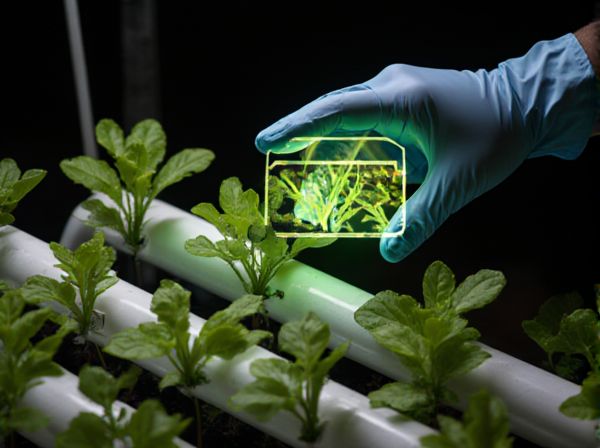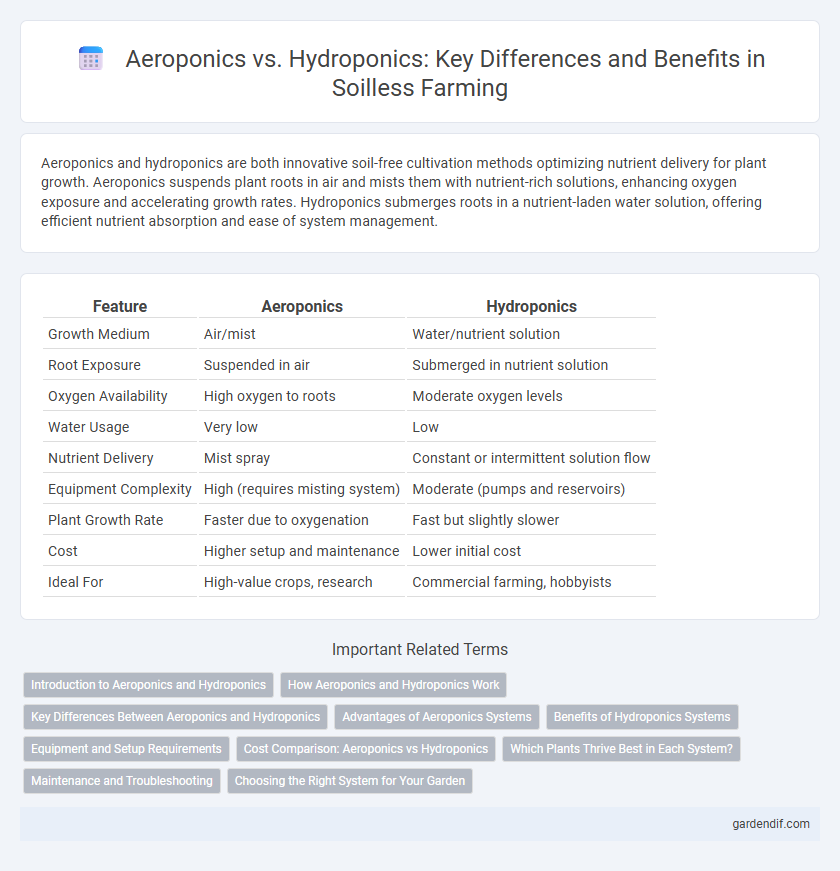
Aeroponics vs Hydroponics Illustration
Aeroponics and hydroponics are both innovative soil-free cultivation methods optimizing nutrient delivery for plant growth. Aeroponics suspends plant roots in air and mists them with nutrient-rich solutions, enhancing oxygen exposure and accelerating growth rates. Hydroponics submerges roots in a nutrient-laden water solution, offering efficient nutrient absorption and ease of system management.
Table of Comparison
| Feature | Aeroponics | Hydroponics |
|---|---|---|
| Growth Medium | Air/mist | Water/nutrient solution |
| Root Exposure | Suspended in air | Submerged in nutrient solution |
| Oxygen Availability | High oxygen to roots | Moderate oxygen levels |
| Water Usage | Very low | Low |
| Nutrient Delivery | Mist spray | Constant or intermittent solution flow |
| Equipment Complexity | High (requires misting system) | Moderate (pumps and reservoirs) |
| Plant Growth Rate | Faster due to oxygenation | Fast but slightly slower |
| Cost | Higher setup and maintenance | Lower initial cost |
| Ideal For | High-value crops, research | Commercial farming, hobbyists |
Introduction to Aeroponics and Hydroponics
Aeroponics and hydroponics are advanced soil-less cultivation methods that optimize plant growth by delivering nutrients directly to the roots. Aeroponics suspends plant roots in air and mists them with nutrient-rich solutions, promoting maximum oxygen exposure and efficient nutrient absorption. Hydroponics submerges roots in a nutrient solution or uses inert media to support plants, offering precise control over water and nutrient delivery for higher yields.
How Aeroponics and Hydroponics Work
Aeroponics delivers nutrient-rich mist directly to plant roots suspended in air, maximizing oxygen exposure and accelerating nutrient absorption for faster growth rates. Hydroponics submerges plant roots in a nutrient-rich water solution, enabling precise control over nutrient delivery and water usage efficiency. Both systems optimize resource use by eliminating soil, but aeroponics emphasizes air and mist for nutrient transfer, whereas hydroponics relies on water immersion.
Key Differences Between Aeroponics and Hydroponics
Aeroponics involves growing plants in an air or mist environment without soil or an aggregate medium, whereas hydroponics uses a nutrient-rich water solution to support plant roots. Aeroponics systems offer higher oxygen availability to roots, leading to faster growth rates and more efficient nutrient uptake compared to hydroponics. Hydroponics typically requires less technological input and is easier to manage, making it more accessible for beginners and large-scale cultivation.
Advantages of Aeroponics Systems
Aeroponics systems offer significant water efficiency by delivering nutrients directly to plant roots through a fine mist, reducing water usage by up to 90% compared to traditional hydroponics. Enhanced oxygen availability around the root zone promotes faster plant growth and higher yields, with some studies reporting growth rates up to 30% faster than hydroponic setups. This soil-free method also minimizes the risk of root diseases and allows for precise control over nutrient delivery, optimizing plant health and productivity.
Benefits of Hydroponics Systems
Hydroponics systems offer precise nutrient control, resulting in faster plant growth and higher yields compared to traditional soil methods. These systems use up to 90% less water than conventional agriculture, making them highly sustainable and ideal for urban farming. The elimination of soil reduces the risk of pests and diseases, decreasing the need for pesticides and promoting healthier crop production.
Equipment and Setup Requirements
Aeroponics systems require misting nozzles, high-pressure pumps, and airtight chambers to suspend plant roots in air, demanding more specialized equipment compared to hydroponics. Hydroponic setups typically use nutrient film technique (NFT) channels, deep water culture (DWC) tanks, or flood and drain tables, which are simpler and more cost-effective. The aeroponic method necessitates precise control of mist frequency and pressure, while hydroponics involves monitoring water nutrient levels and oxygenation with relatively straightforward apparatus.
Cost Comparison: Aeroponics vs Hydroponics
Aeroponics systems typically require higher initial investment due to advanced misting technology and precise environmental controls compared to hydroponics, which relies on nutrient-rich water solutions and simpler infrastructure. Operating costs for aeroponics can be higher because of energy demands for pumps and misting cycles, while hydroponics often benefits from lower energy consumption and easier maintenance. Despite the greater upfront and operational expenses, aeroponics offers faster growth rates and potentially higher yields, which may offset costs in long-term cultivation.
Which Plants Thrive Best in Each System?
Leafy greens such as lettuce, spinach, and kale thrive exceptionally well in hydroponic systems due to their fast growth rates and shallow root structures that benefit from nutrient-rich water solutions. Aeroponics is ideal for plants like strawberries, tomatoes, and herbs, which require high oxygen levels and aeration directly to the roots for optimal growth. Root vegetables generally perform better in hydroponics, whereas aeroponics enhances the growth of delicate plants needing precise humidity and nutrient misting.
Maintenance and Troubleshooting
Aeroponics requires meticulous maintenance to prevent nozzle clogging and ensures optimal mist delivery to plant roots, while hydroponics demands regular monitoring of nutrient solutions and water pH levels to avoid root rot and nutrient imbalances. Troubleshooting in aeroponics often involves resolving airflow and spray system disruptions, whereas hydroponics issues typically stem from pump failures or algae growth in the nutrient reservoirs. Both systems benefit from routine inspections and adjustments to maintain ideal growing conditions and maximize crop yields.
Choosing the Right System for Your Garden
Aeroponics delivers nutrient-rich mist directly to plant roots, promoting faster growth and higher oxygen levels, while hydroponics uses nutrient-filled water to support plants in a soil-free environment. Selecting the right system depends on factors like space availability, budget, and the types of crops grown, as aeroponics suits high-tech setups and hydroponics works well for beginners and larger scales. Gardeners should consider system maintenance, water usage efficiency, and desired yield when choosing between aeroponics and hydroponics for optimal growth.
Aeroponics vs Hydroponics Infographic

 gardendif.com
gardendif.com